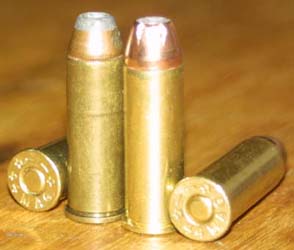

| Back to The Collection | Back to Home |

|
|

|
| Birth | Growth | Maturity |
| Offspring | Carbines | Links |
|
Do you feel lucky?
This essay is meant to be, if not a tribute, at least a rather subjective
look at the cartridge which has become synonymous with handgun power.
The mighty .44 has crossed over, from the culture of hunters and gun enthusiasts,
to the mainstream. I have gathered the facts at various other places on
this site. There are the specs of the cartridge itself, and then brief pages
about the individual guns. I own, and have fired, every gun I have written
about, and can speak firsthand of their handling, accuracy, strengths and
weaknesses. This essay is not about the facts. This page will concern itself
with the lore, following, and aura which have grown up around the classic
44 and the guns which fire it. This round will forever be associated with Dirty Harry, and the S&W Model 29 revolver. Though there are certainly better cartridge/handgun combinations for police use, and a number of different, and stronger, revolvers have been produced in the mighty 44, legends die hard. To many people, this will always be the world's most powerful handgun, despite efforts by firearms designers to surpass it. The reasons for this mystique defy logic, so rather than looking at the facts, an examination of attitudes must be undertaken. Could it be something more than sheer power, which has made this cartridge such a legend? 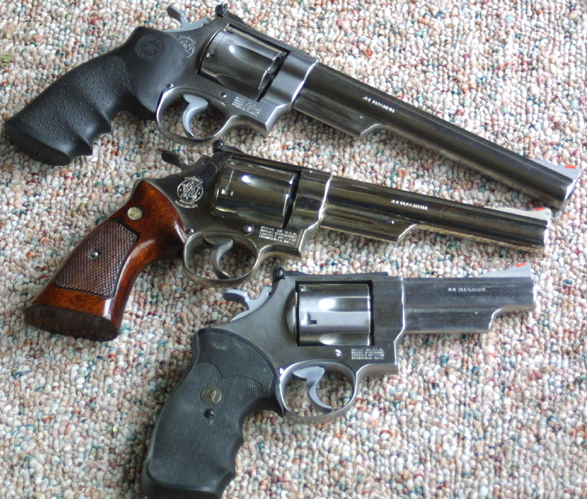 frames, put some 44 barrels on them, and chambered them for a round
a bit longer than the old 44 special. A legend was thus born. In 1957,
the 44 magnum was designated as the model 29, and was given a heavier barrel,
and a longer cylinder. Though the longer cylinder was added entirely to
increase weight, and improve the handling qualities of the gun, it would
not be too many years before some intrepid handloads (and factory loads
too) began to use longer, heavier bullets which took advantage of the extra
length.
frames, put some 44 barrels on them, and chambered them for a round
a bit longer than the old 44 special. A legend was thus born. In 1957,
the 44 magnum was designated as the model 29, and was given a heavier barrel,
and a longer cylinder. Though the longer cylinder was added entirely to
increase weight, and improve the handling qualities of the gun, it would
not be too many years before some intrepid handloads (and factory loads
too) began to use longer, heavier bullets which took advantage of the extra
length. The .44 magnum has become a legendary cartridge. This, and the guns which fired it, had achieved a sort of celebrity status, back in the seventies, and eighties. Whenever a new cartridge, or wildcat load was developed, it was always measured against the mighty .44. The .41 magnum is said, by it's supporters to be "almost" as powerful as the .44. The old Wildey .45, and Detonics .451, were said to be "pretty close." These attempts at greatness have fallen by the way, while the .44 remains, after several decades, as the premier handgun cartridge. This is not to say that the round remains unchallenged. There is now the .454 Casull, which is said to be "better" than the old .44. There are also the .45 Roland, and .45 Super, which are reputed to be pretty close. The interesting thing about all of these over powered cartridges, is that they are all described in relation to the old standard, .44 Magnum. The most prized gun of the times was the S&W Model 29. This was the original 44 Magnum, and was Dirty Harry's gun. These guns were almost impossible to find, throughout most of the seventies, because they had actually gone out of production, sometime in the late sixties. After the Dirty Harry movies increased demand for these revolvers, Smith and Wesson reinstated production of the guns, but they were generally only available for two to three times their list price. Most 44 shooters owned the single action Ruger Super Blackhawk. Theses guns were more affordable, produced in large quantities, and were somewhat heavier and stronger than the M-29. There were only a few commercial loads available at the time. The standard load consisted of a 240 grain slug driven at velocities of 1400-1500 feet per second. This is a pretty hefty load, and is not pleasant to shoot, though it can be mastered in time. Handloading was considerably less widespread than it is today, so most of the shooters of the time, used the small selection of factory loads. This scarcity of loads was probably the biggest stumbling block to learning to use the big 44. I was never much of a fan of the .44 Magnum, back in the seventies. Though there was a certain appeal to the title of the most powerful handgun, the cartridge, and the guns which fired it, had always seemed to be overpriced, and overly powerful. There was always the suspicion that the old N frame revolvers, designed at the turn of the century, were not quite up to the power of the more recently designed cartridge. There was also a certain resistance against the trendiness of the round; it seemed a bit of a firearms fad. The sixties, seventies, and eighties seemed a time of foolish diversions, and overstated garishness; the .44 Magnum did seem to be a round all too suited to the times. Many of the shooters, whom I derided for their "magnum fever" proved me right. Numerous Model 29 Smiths were seen in used gun cases, though they would be quickly snatched up. Shooters generally found that the gun was unpleasant to fire, and the ammunition was too expensive. There was also some talk of the guns going out of tune, when subjected to steady diets of full house .44 loads. To top it all off, the gun was considered too dangerous to be a serious defense tool. The rounds would penetrate walls, cars, and people, endangering anyone who might be in the vicinity of the shooter. Just when I began to feel smugly superior, for my cool head, and practicality, in dismissing the round, things began to change. While most of those afflicted with magnum fever, passed through the various stages, and recovered. Others seemed to have caught a terminal version, and stuck with their guns, learning to deal with the problems that the .44 presented. Previous to the Dirty Harry movies, few people had any familiarity with the .44 Magnum. It was seen as a hunters tool, and the men who used 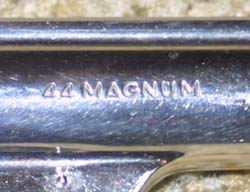 it, tended to be skilled shooters. The sudden popularity of the gun,
with the general public, spawned the usual mishaps expected at the back
end of any learning curve. It would be as if everyone, rather than just
a small group of enthusiastic drivers, had suddenly decided to own a Ferrari,
with a slew of high speed accidents being the result. This would be particularly
true if all of the new Ferrari drivers decided that they must drive at
the car's top speed at all times, or otherwise be in danger of wasting the
potential of the car. Then there would be those who would attempt to use
their Ferrari as a grocery getter, and commuter, sitting in traffic jams,
and trying to find room in the tiny trunk for a bag of vegetables. Burnt
out valves, carbon deposits, and frequent tune ups would be the result.
it, tended to be skilled shooters. The sudden popularity of the gun,
with the general public, spawned the usual mishaps expected at the back
end of any learning curve. It would be as if everyone, rather than just
a small group of enthusiastic drivers, had suddenly decided to own a Ferrari,
with a slew of high speed accidents being the result. This would be particularly
true if all of the new Ferrari drivers decided that they must drive at
the car's top speed at all times, or otherwise be in danger of wasting the
potential of the car. Then there would be those who would attempt to use
their Ferrari as a grocery getter, and commuter, sitting in traffic jams,
and trying to find room in the tiny trunk for a bag of vegetables. Burnt
out valves, carbon deposits, and frequent tune ups would be the result.
A surprising thing began to happen though. As large numbers of shooters were exposed to the round, a certain amount of experience, and lore began to accumulate. Even as many shooters abandoned the round, in favor of more forgiving, and more comfortable rounds to fire, others worked with the cartridge. The popularity of the .44 magnum, motivated some other gun makers to produce guns chambered to fire it. This popularity also spawned a variety of factory rounds. It seemed that some of the Ferrari owners were learning that they needed to treat their Ferraris like Ferraris. At the same time, many former Ferrari owners had learned the error of their ways, and understood that what they really wanted was a Ford. In addition to the newly expanded selection of loads, ammunition and pistols, the introduction of a series of carbines, and the newly popularized hobby of hand loading has taken the 44 Magnum way beyond the potential it had as a hand canon in the sixties, and seventies. The hand canon loads are still there, for those who must, but there is now a new set of versatile low powered handloads which can make the 44 perform on a par with the 45 ACP, 45 LC, or any number of other rounds. New powders, reinforced frame guns, and longer barrels have made some of today's maximum power loads objects of awe. This is where the new versatility comes into play. With maximum power loads, and a long barreled revolver, there is no animal in the world, including bear, and moose, that can not be taken. On the other hand, with some of the medium powered loads, the 44 is now an excellent defense round. Bullets are available in various styles, and in weights from 180 to 325 grains. Use of low powered loads, or of 44 Special rounds, make sport and target shooting, pleasant enough, even for extended sessions. What more could be asked for in the way of versatility? Adding even more to the versatility of the 44 Magnum, is it's use as a carbine round. There were essentially two guns which began this process. One was the Ruger 44 magnum autoloading carbine, the other was the lever action Winchester, and a series of clones to come. Deer hunters, particularly in the woodlands of the East, took to the use of the 44 like it was the answer to a prayer. These carbines quickly developed a reputation as brushbusters, implying that the heavy rounds would cut through twigs and leaves which might deflect some of the lighter, faster, more traditional hunting cartridges. In the open spaces of the West, there was less excitement over it's use as a hunting round, and a quick acceptance of the 44 carbine as a ranch gun, or general purpose arm. The use of the mighty 44 in longarms, turns a rather brutish handgun cartridge into a very pleasant and manageable carbine round. This is just the thing for defense, plinking, and general purpose shooting. Add to this, the fact that the 44 is less expensive to feed than your average rifle, while being a lighter gun to carry, and the appeal of these guns, as general purpose or knock around guns, becomes obvious. There are other good reasons for using a pistol and longarm chambered for the same cartridge. Many hunters, who would previously not have carried a 44 pistol, became believers after having fired a 44 carbine. They could afterwards be seen in the woods with a 44 pistol on the belt, and a matching 44 carbine slug over the shoulder. The same ammunition belt would feed both guns. For the increasingly popular sport of handgun hunting, held in rather low esteem previous to the eighties, the 44 was to be the first choice. 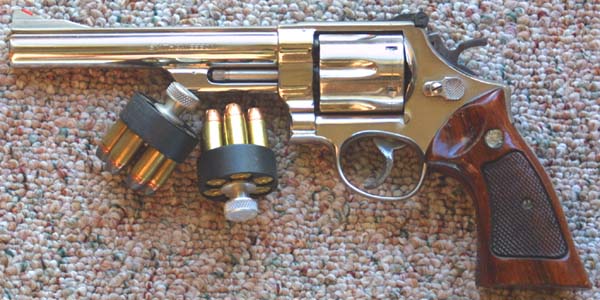 29 in 1957. This gun has it's own page, on
this site, but there are a few things I might add. S&W seemed to have
an odd ambivalence towards this gun. On the one hand, it was their top
of the line revolver for decades. On the other hand, the model was in and
out of production until sales took off in the early seventies, at which
time production numbers stayed rather low, and prices skyrocketed. It might
be thought that S&W was limiting production to keep prices high, but
they never changed the price charged to dealers, even when the guns were
selling for top dollar. It was the dealers, and the distributors who were
gouging the public, rather than S&W itself. What this did was to encourage
other manufacturers to introduce models in competition with the overpriced
S&W model. The gun was latter offered in stainless steel, as the model
629, the only model currently produced.
29 in 1957. This gun has it's own page, on
this site, but there are a few things I might add. S&W seemed to have
an odd ambivalence towards this gun. On the one hand, it was their top
of the line revolver for decades. On the other hand, the model was in and
out of production until sales took off in the early seventies, at which
time production numbers stayed rather low, and prices skyrocketed. It might
be thought that S&W was limiting production to keep prices high, but
they never changed the price charged to dealers, even when the guns were
selling for top dollar. It was the dealers, and the distributors who were
gouging the public, rather than S&W itself. What this did was to encourage
other manufacturers to introduce models in competition with the overpriced
S&W model. The gun was latter offered in stainless steel, as the model
629, the only model currently produced. If the Model 29 introduced the 44 Magnum, and Dirty Harry made it famous, it was the Ruger Super Blackhawk, which first put the cartridge within the means of the average shooter, and helped to popularize it. This was a more massive framed version of Ruger's popular blackhawk series of Single action pistols. The Blackhawks were nominally clones of the old Colt SAA, but over the years, so many changes had been made to the design that they were mechanically quite different, and physically only 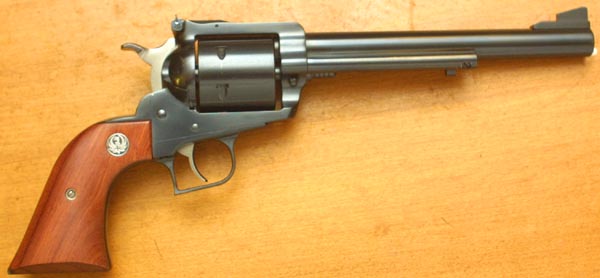 vaguely resembled the old Colt design. The Ruger was available with
adjustable sights, and was eventually produced in stainless steel. The
gun was available with 4 5/8 inch barrels, as well as a 10 inch barrel,
but by far the most popular was the 7 1/2 inch model. Throughout the sixties,
seventies, and into the eighties, this was really the only readily available
44 Magnum handgun, particularly of cost was a factor.
vaguely resembled the old Colt design. The Ruger was available with
adjustable sights, and was eventually produced in stainless steel. The
gun was available with 4 5/8 inch barrels, as well as a 10 inch barrel,
but by far the most popular was the 7 1/2 inch model. Throughout the sixties,
seventies, and into the eighties, this was really the only readily available
44 Magnum handgun, particularly of cost was a factor. The Ruger had all of the well known deficiencies common to the single action design. These deficiencies, though important to the combat shooter, are nearly moot for the hunter or target shooter. First among them is the cumbersome reloading process, requiring the gun to be put at half cock, and reloaded, one chamber at at time, after the empties are punched out. This can be a real problem for the combat or self defense shooter. The other problem is that the gun can not be fired rapidly, needing to be cocked for each round. Of course, this may be a moot point for both hunting, and combat shooters, since no one is really capable of rapid fire, double action shooting with a cartridge of this power (there are some who may argue this point with me, but it is, for the most part, true). The Ruger redhawk came out in 1978, or at least, this is what the gun magazines said. In truth they were not to be found anywhere but in gun magazines, and at astronomical prices at gun shows, until at least a year or two latter. The gun was 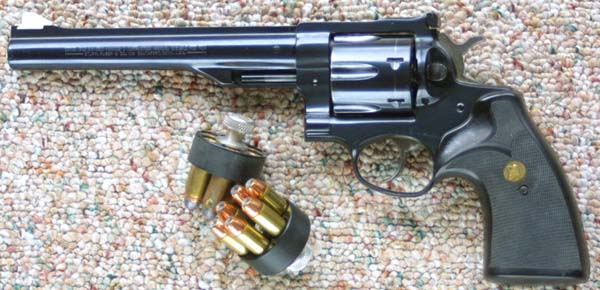 introduced in stainless steel, with a blued, chrome moly steel model
introduced latter on. These were designed as hunting guns right from the
start, unlike the target oriented N frames from Smith and Wesson. The Redhawk
frame is larger, and heavier than the N frame, and has a more modular design.
One big selling point of the Ruger was that, once the supply caught up with
demand, it was available for considerably less money than the big Smith.
In more recent years, Ruger has introduced the even heavier, Super Redhawk.
These gun are designed specifically for hunters, and there are no pretensions
of there being any defense or target applications. The super Redhawk has,
besides the heavier frame, a set of notches compromising an integral mounting
system for a set of scope rings.
introduced in stainless steel, with a blued, chrome moly steel model
introduced latter on. These were designed as hunting guns right from the
start, unlike the target oriented N frames from Smith and Wesson. The Redhawk
frame is larger, and heavier than the N frame, and has a more modular design.
One big selling point of the Ruger was that, once the supply caught up with
demand, it was available for considerably less money than the big Smith.
In more recent years, Ruger has introduced the even heavier, Super Redhawk.
These gun are designed specifically for hunters, and there are no pretensions
of there being any defense or target applications. The super Redhawk has,
besides the heavier frame, a set of notches compromising an integral mounting
system for a set of scope rings. I would consider the Redhawk to be a bit of an improvement on the classic Model 29, though opinions vary. Certainly the Redhawk is the stronger gun, but there are some who claim that the Smith can edge it out in accuracy, and that the trigger pull is better. Other people say the exact opposite. In my own personal experience, I have found the Smith to be the more accurate gun, and I prefer it's trigger pull to that of the redhawk. Though the redhawk has a lighter double action pull, it does not have the crispness of the Smith's, and the single action pull just does not compare at all. These are all subjective things, of course, and your experiences might differ from mine. At any rate, the gun is no slouch, and either model should be more than sufficient for hunting, or target use. The single shot Thompson Contender was one of the first handguns to be made available in 44 Magnum. This gun is 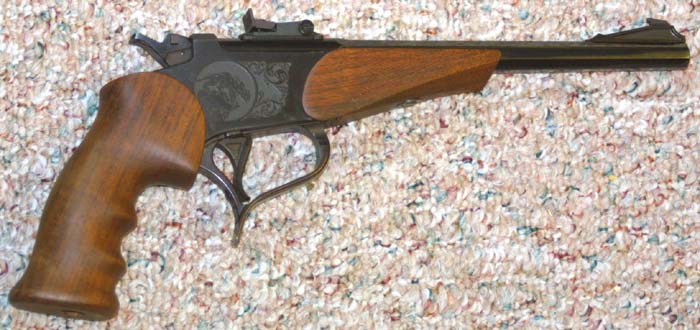 designed entirely as a hunters tool. The single shot, single action,
along with the very heavy chamber and barrel, make this one of the top
performing 44 Magnum pistols around. In addition to being able to handle
hot loaded 44's, the Contender barrels in this caliber are generally equipped
with chokes for firing 44 Magnum shot shells. The chokes have an odd cloverleaf
patter, which is designed to straighten the path of the shot, after it
emerges from the rifled barrel. Available with barrels as long as 14",
and with it's extra strong chamber, the Contender is almost like a stockless
carbine, as far as ballistics are concerned.
designed entirely as a hunters tool. The single shot, single action,
along with the very heavy chamber and barrel, make this one of the top
performing 44 Magnum pistols around. In addition to being able to handle
hot loaded 44's, the Contender barrels in this caliber are generally equipped
with chokes for firing 44 Magnum shot shells. The chokes have an odd cloverleaf
patter, which is designed to straighten the path of the shot, after it
emerges from the rifled barrel. Available with barrels as long as 14",
and with it's extra strong chamber, the Contender is almost like a stockless
carbine, as far as ballistics are concerned. Dan wesson was one of the first gunmakers, after Smith and Wesson, to introduce a double action pistol in 44 Magnum. On their introduction, these were the heaviest frame double action revolvers available, though this distinction lasted only a few years. These guns are best known for their interchangeable barrels. They are available in blue steel, or stainless steel, with plain, vent ribbed, or underlugged vent ribbed barrel shroud styles. The Dan Wesson is probably the most accurate 44 Magnum revolver made, because of the tension under which the interchangeable barrel tubes are kept. The trigger pull is very light, but has an odd feel, when compared to that of the model 29. Part of this may be due to the arc of the hammer, which seems to be a bit less than that of the Smith or the Ruger. The Dan Wesson Company has gone in and out of business several times, over the years. The quality of the guns has varied 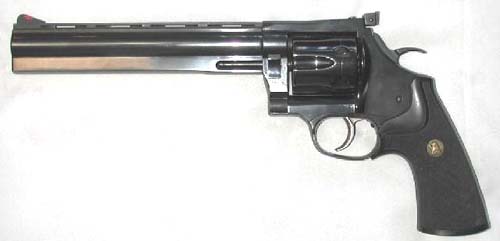 from excellent to fair, depending upon the date of manufacture. The
present models, made in New York, are excellent, but also very expensive.
The old Monsoon, MA plant made excellent guns during the seventies, and
most of the eighties, but quality dropped some, during the late eighties,
and into the nineties. Though the quality never dropped down into the poor
range, during hard times, Dan Wesson cut corners a bit on their quality
control. The first guns were produced, under contract, by High Standard,
which also produced a 44 Double action revolver of it's own, called the
Crusader. The large frame High Standard Revolvers strongly resembled the
Dan Wesson, though they did not have the interchangeable barrels.
from excellent to fair, depending upon the date of manufacture. The
present models, made in New York, are excellent, but also very expensive.
The old Monsoon, MA plant made excellent guns during the seventies, and
most of the eighties, but quality dropped some, during the late eighties,
and into the nineties. Though the quality never dropped down into the poor
range, during hard times, Dan Wesson cut corners a bit on their quality
control. The first guns were produced, under contract, by High Standard,
which also produced a 44 Double action revolver of it's own, called the
Crusader. The large frame High Standard Revolvers strongly resembled the
Dan Wesson, though they did not have the interchangeable barrels. The Super Blackhawk was far from the only single action produced in 44 Magnum. There were numerous single action revolvers in this caliber, of varying quality, introduced for cowboy action shooters, and collectors, or for those who could not  afford the classic Smith, or even the Blackhawk. Some were made domestically,
but most seem to have been made in Germany, Italy, South America, or
Spain. Quality could be very good, but in many, particularly during the
seventies, when the 44 was in short supply, it could be fair to dismal.
afford the classic Smith, or even the Blackhawk. Some were made domestically,
but most seem to have been made in Germany, Italy, South America, or
Spain. Quality could be very good, but in many, particularly during the
seventies, when the 44 was in short supply, it could be fair to dismal.
Taurus produces it's model M44, an unabashed copy of the S&W N frame, in 44 magnum. It also produces the massive Raging Bull, in both 44 Magnum, and 454 Casull. Both guns are available in blue or stainless steel. The Taurus M44 is the equal of the S&W, some say it is even better. Undercutting the Smith a bit on price, makes the Taurus one of the great handgun bargains, though their prices are slowly rising as they get more of a following. The raging Bull is one of the most massive double action revolvers I have ever seen. Not only is the frame large and heavy, but the triangular shroud over the barrel is huge, making the gun difficult to holster. Still, the weight helps to keep recoil manageable. Overall, Taurus makes a fine series of revolvers, which are reasonably priced. Israeli Arms introduced the Desert Eagle. This was not the first high powered automatic, nor was it the first which called itself a magnum, but it was the first automatic which was able to fire the standard magnum handgun rounds. The Desert Eagle is a gas operated pistol, unlike most semi auto pistols, which tend to be recoil operated. It uses a rotating bolt, not unlike that used in the M-16/AR-15 series of rifles. Initially introduced in 44 Magnum, the gun was eventually produced in 41 Magnum, 357 Magnum, and 50 caliber versions. It is possible to get conversion kits which will allow conversions of some of the more recent versions (from Mk VII onwards) of the basic gun to fire more than one caliber. The guns are dependable, and accurate, but are 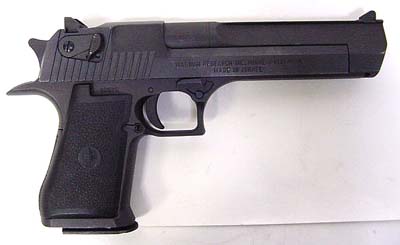 very heavy and bulky. A Desert Eagle weights something on the order
of five pounds, and is 11 inches long. These guns are also thick, and
the large magazine, dictated by the long cartridges, requires a rather
large grip. The magazine holds 8 rounds, two more than revolvers in this
caliber. Still, the gun is just too big for me, and I vastly prefer the
more traditional revolvers.
very heavy and bulky. A Desert Eagle weights something on the order
of five pounds, and is 11 inches long. These guns are also thick, and
the large magazine, dictated by the long cartridges, requires a rather
large grip. The magazine holds 8 rounds, two more than revolvers in this
caliber. Still, the gun is just too big for me, and I vastly prefer the
more traditional revolvers. The barrel is fixed to the frame, and does not recoil. It is also completely uncovered by the slide (functionally, the slide of the Desert Eagle is functionally more like the bolt of a semi auto rifle, than the slide of a semi auto pistol). It features polygon rifling, like that used in the H&K series of pistols, and is available in lengths from six to twelve inches, which are easily changed by the user. The slide houses an ambidextrous safety, and is reminiscent, in appearance to that of the Browning Buckmark. These guns have generated quite a following among hunters, and those who must have the biggest and most powerful. The introduction of these many other models only became possible when the round itself really took off with the public, in the early seventies. Developing a new handgun is no small matter, and a manufacturer does not so such a thing lightly. These days, the future popularity of the 44 Magnum is assured, not just as a hunter's tool; but as a useful range of handguns with a variety of loads available to suit nearly any purpose for which a handgun could be used. One of the factors which contributes to the amazing long lasting popularity of this cartridge is the introduction of a number of carbines chambered for it's use. The most famous, and one of the more highly regarded examples is that of the old Ruger 44 Magnum Carbine. This gun used a four shot tubular magazine, and was patterned after the old M-1 Carbine of W.W.II. The 4 round capacity of the tubular magazine gave the carbine a bit less firepower than the 6 shot revolvers to which it was a companion piece. This was more than made up for by the superior ballistics, and accuracy of the 16" barrel, and by the rapid fire of the semi auto action. The gun went out of production decades ago, and has been mourned. Recently, the design had a resurrection of sorts, with the introduction of the new Deerfield rifle, by Ruger. the new rifle is about the same size, and retains a 4 round magazine, though this is now a detachable rotary magazine, rather than a fixed tubular one. Many of the 44 carbines on the market are lever action guns. Revolver rounds are quite easily adapted to lever action use. The revolver cartridge headspaces on the rim, and those wide rims make the rounds well suited to the tubular magazine, and to the method of feed of the classic lever action. Style wise, the lever action is a great companion to the large number of single action 44 Magnum pistols on the market, and is not out of place with the more modern double action revolver. A tubular feed lever action can have a magazine capacity of ten rounds, and offers little recoil, and nearly the same rapid fire capability as a modern semi auto. One of the best reasons to own a 44 carbine, is for use as a companion to a 44 Magnum pistol. The carbine barrel increases velocity, and greatly increases  accuracy and effective range, while the pistol serves as a handy arm
for off hand shooting, or closer range. This is how many cowboys, guides,
explorers, and homesteaders were armed. The combo cartridge back in those
days was the 44-40, and those so armed had few complaints. The 44 magnum
is a far better round, and would have been the answer to a prayer for those
who settled the frontier a century and a half ago.
accuracy and effective range, while the pistol serves as a handy arm
for off hand shooting, or closer range. This is how many cowboys, guides,
explorers, and homesteaders were armed. The combo cartridge back in those
days was the 44-40, and those so armed had few complaints. The 44 magnum
is a far better round, and would have been the answer to a prayer for those
who settled the frontier a century and a half ago.Though it has been exceeded by a number of other rounds, in the last few decades, there still exists some magic in the old 44 Magnum. As with the muscle cars of the sixties, with some car enthusiasts, the mighty 44 will always be at the top of the heap with many gun enthusiasts.
|